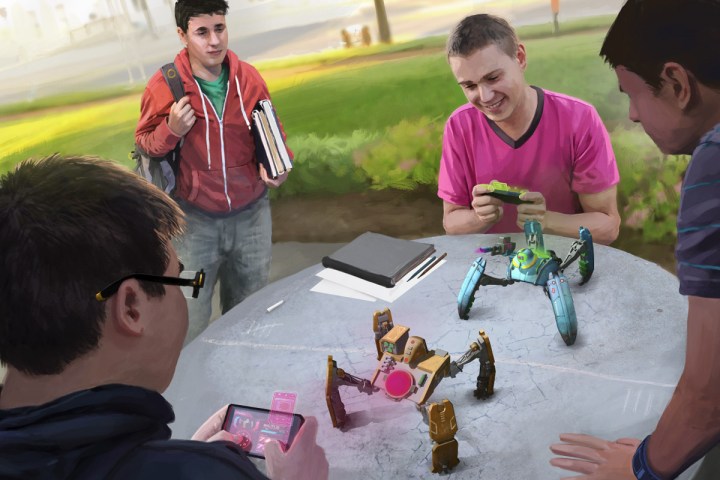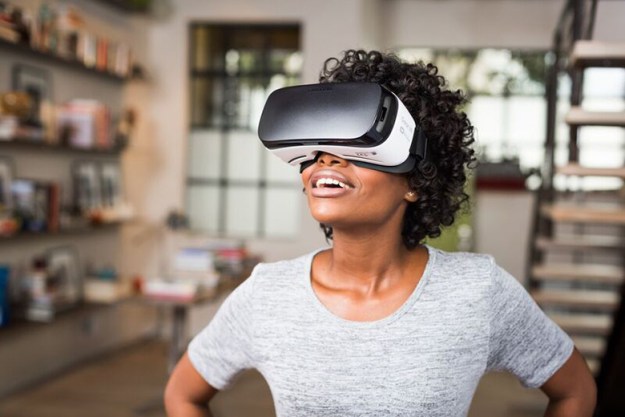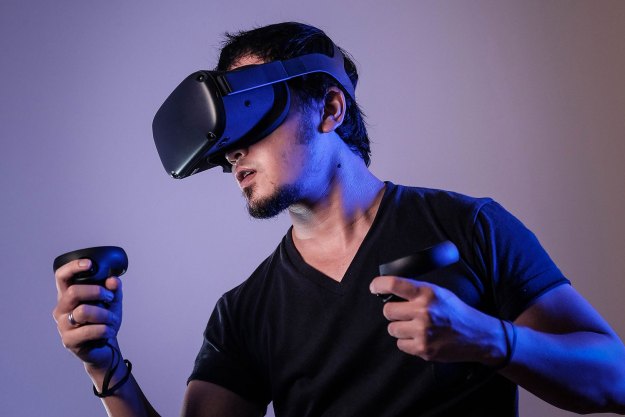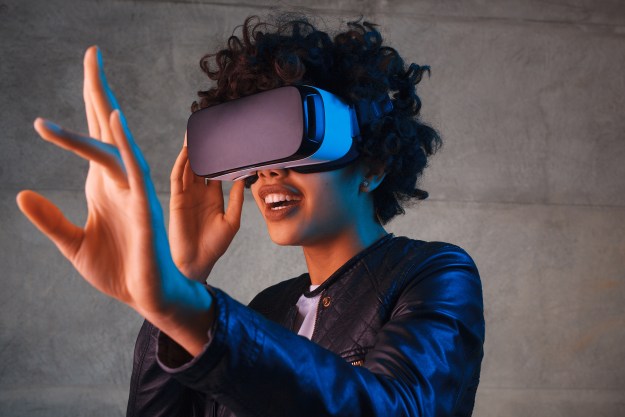
Augmented reality projects like the Microsoft HoloLens and the Magic Leap promise to merge the virtual with the real in a way that’s more visceral than a full VR experience. But these specific projects are just one part of a spectrum that ranges from headsets that stimulate sight and sound to mixed-reality experiences that can be accessed on a game console or smartphone.
Think Activision’s Skylanders, Disney’s Infinity, Nintendo’s Amiibo, and Anki’s Overdrive. These take physical toys, models and figures that have a limited function in our real world, and give them expansive abilities in a digital one.

The implementation is different in each case, but the success is undeniable. Although Nintendo has struggled as of late, the company’s Amiibo line was a big win. Nintendo made close to $2 billion dollars in a single quarter in 2015 purely from Amiibo sales. Skylanders and Disney Infinity have been similarly giant franchises for both parent firms, now worth billions a piece as their own self-sustaining industry.
What is it about these mixed reality games that make them so successful? Traditional thinking would have had both Disney and Activision make their respective games with no physical component whatsoever. The characters, costumes and other upgrades could be delivered as downloadable content (DLC), and the game would function the same. Theoretically, they’d be better for it, since there’d be no need to buy and swap out expensive physical items. Yet augmented reality is clearly what gives these experiences an edge.
The benefits of both worlds
Anki is the maker of Overdrive slot-less, slot-car racers that utilize AI driven cars and smartphone controls to add whole new levels to the classic living room racing experience. The toy has proved a winning combination over the past few years, earning it several awards at toy tradeshows.
By combining the real and the virtual, developers can harness the attachment to people feel to physical items.
“People have an emotional connection to a physical product they can hold in their hand” said Mark Palatucci, co-founder of Anki. “But video games can be a lot more fun. They’re adaptive, they scale the difficulty with the skill of the player. Overdrive takes the emotion and powerful connection with a physical product and combines it with the magic that makes video games so engaging.”
Silas Adekunle, founder of Reach Robotics – which makes real-life robots with augmented reality features – agrees. “People love to play with toys,” he said. “And that’s when they are happy to make big purchases, too. They’ll spend $100-$200 on a physical product, where they wouldn’t spend anything like that on a game.”
But like the guys at Anki, Adekunle realized that the robots he and his friends were looking to build would need to do more than look cool. He taught robotics to children and teens while attending university and found that although they were interested at first, maintaining any level dedication was difficult.

It was only when he began gamifying the process of developing and maintaining the robots that the children became engaged. That’s what sparked the development of Reach Robotics, and its first major product, Mekamon.
If there’s a mixed reality spectrum, Anki and Reach’s products exist on the opposite end of Amiibo and Skylanders figures. They are more heavily dependent on the physical world, with digital augmentation, rather than the other way around. This was not an accident, but a trait selected with purpose.
“People love to tinker with physical products,” said Reach Robotics’ Jonathan Quinn. highlighting that physically altering the Robots will be a major component in the Reach experience. Plus, he said with an obvious smirk in his voice, “we don’t have any of the problems of something like VR.”
Indeed, using the real world to craft a game environment means there’s no headaches, no nausea, no frame rate drops, no narrow field of view. Everything is ready to go by default, and a smartphone provides a simple doorway into the augmented world.
But what bringing digital content to the table does, is allow these developers to build games and experiences that just aren’t possible with physical hardware alone. In the case of Reach Robotics, the idea – when they are finally released – is to have players battling one another’s robots, firing off lasers and missiles, and attacking each other’s various hitpoint stats with movement and tactics, until one emerges victorious.
Of course, this wouldn’t work if the robots functioned in reality alone. Hardware wouldn’t last long, controls would be difficult to master, and anything capable of doing damage to a robot would be an automatic safety hazard. Augmented reality solves all these problems, providing more information to the player and simulating effects of combat on the real-world robots.
Smart toys, smartly made
Augmented reality toys also benefit from being smart. Very smart. In the case of Anki’s cars, each has a 50MHz processor inside, as well as the ability to leverage the capabilities of the Bluetooth connected smartphone for added processing power. This means the cars can perform complex tasks, like mapping out a track, and also operate in accordance with on-board AI.

“We have 27 AI Commanders right now,” said Anki’s Palatucci. “They act as virtual drivers, and we’re able to tune the difficulty and personalities of these drivers in a dynamic way. They all have their own art styles, voice actors and styles of driving, which we can tune to make them more aggressive and each of them have their own favorite weapons and items.”
This is something that is just not possible with a traditional physical toy. Indeed, if you are familiar with the slot cars of years gone past, the fun came from playing with friends – because all you could do otherwise was race yourself.
What Anki has created is a game that is not only fun as a multiplayer experience, but great fun and even more in-depth as a single player one. You can level up, unlock new items and weapons, upgrade your car, and face off against AI Commanders, all because Overdrive is augmented through its mixed reality design.
These take physical toys, models and figures that have a limited function in our real world, and give them expansive abilities in a digital one.
Although not as far along in development as Anki’s products, Reach Robotics is looking to do something similar. Along with the multiplayer battles, there will be a whole single player experience also.
“When we launch our product, we want to provide both physical and augmented reality game modes,” said Adekunle. “The virtual world will help provide a back story and variety to the game, adding a lot of different types of mechs.”
Reach Robotics plans to launch a singular robot starter kit when the product debuts in the next year or so, but by leveraging augmented reality, whereby a user views their robot through their phone, single player levels, battles, and all sorts of additional content can be added to the game, all without needing to develop a whole new line of physical products.
There will be physical upgrades, part kits, and weapon packs that players will be able to add to their robot, but much of the additional content provided after launch, as with Anki’s Overdrive, will be digital.
“The product you buy on day one, is going to be very different than what you have a month on,” said Anki’s Palatucci. “We’re constantly updating the app with new features, new gameplay. We release an update every month or so, giving even the people who purchased as recently as Christmas a lot of new content to play with.”
Perhaps the most exciting aspect of mixed reality gaming is its potential for expansion. As AR headsets like Hololens and Magic Leap are further developed, could we see the toys these guys make augmented with additional features and visual effects, all enabled by augmented reality headsets?

“Absolutely, we’d definitely look to work with them,” said Adekunle. Though Jonathan Quinn, the company’s lead robotics game developer, did clarify that would depend on the APIs both companies make available for third party developers to work with.
Conclusion
Though it sometimes feels like the attachment we have for physical products might come from the era we were born in, there is no denying that everyone still gravitates to physical toys and products over digital items. That’s something that cannot be replicated with a digital only product, but likewise, the digital can accomplish things not possible in the real world. By combining the real and the virtual, developers can harness the attachment to people feel to physical items with all the flexibility and convenience of a digital item.
That’s what strikes us the most about mixed reality games – the potential. Whether through regular updates, augmented reality, or the possibility for future expansion, they can be endlessly iterated upon to create brand new ways to play.
Maybe VR isn’t a threat to reality. Developers are starting to learn VR’s tricks, and combining them with real items to make unique experiences that even the most realistic VR experience can’t compete with.
Editors' Recommendations
- How Nvidia and AMD could make Windows laptops feel like MacBooks
- New leak reveals exactly how Apple’s VR headset will work
- Apple’s Reality Pro headset is the VR industry’s ‘last hope’
- We now know how Apple’s VR headset may handle video, and it’s pretty awesome
- Apple’s AR/VR headset gets one step closer to a reality




